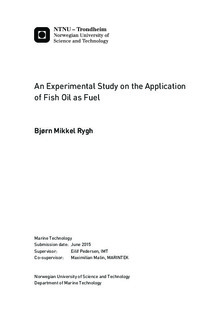| dc.description.abstract | Two fish based bio oils in blends with MGO (Marine Gas Oil) have been tested in a constant volume combustion chamber (CVCC). The CVCC has optical access and a high-speed camera has captured images of the spray formation. These images have been analysed and penetration length, cone angle, lift-off length and combustion intensity has been determined. The intensity has been used for qualitative determination of soot formation. Pressure data has been recorded and used for analysis of heat release and ignition delay. Both combusting and non-combusting sprays have been analysed and the fuel has been injected at three injection pressures; 800 bar, 100 bar and 1400 bar. For each fuel, eight injections have been done at each test point and three different images techniques have been used to capture images. The results have been compared to the results of tests with pure MGO and the goal has been to find out if these bio oils can be used as an alternative to MGO in the future.
The two fish oils that have been tested are Fatty Acid Ethyl Ester (FAEE) and Crude Fish Oil (CFO). They have different depth of processing and significant differences in kinematic viscosity. FAEE has been transesterified and resembles MGO in fuel characteristics, whilst CFO is a viscous liquid and is currently being used as a dietary supplement for animals. FAEE has been tested in blends of 93% MGO/7% FAEE and 50/50% as well as pure. Due to the high viscosity of CFO, this oil has only been tested in 93% MGO/7% CFO and 50/50% blends. All fuel blends are by volume.
Both bio oils are oxygenated, and based on the results of this study, this has a positive effect on combustion efficiency. The combustion intensity, and hence the soot formation, is shown do decrease with increasing bio oil blend ratio. Especially for pure FAEE, the reduction was significant. Ignition delay is shown to be unaffected by blend ratio, but the results show a decreasing relation with increasing injection pressures. This is believed to be because of the increasing injection velocity and spray jet turbulence with corresponding better atomization at higher injection pressures.
The spray characteristics show a dependence on fuel viscosity and the results for FAEE show that increasing FAEE blend ratio causes longer spray penetration and narrower cone angles. This is as expected due to that higher viscosity causes a bigger pressure drop over the injector. This pressure drop affects the atomization process and results in larger fuel droplets with increasing viscosity. Bigger fuel droplets has a higher momentum, which is an important factor in spray development. The lift-off length is increasing with increasing viscosity for the same reason. Worse atomization causes worse air/fuel mixing and the fuel penetrates longer before an ignitable mixture is obtained. For the CFO blends, these spray characteristic relations are not as prominent and the results are more ambiguous and unclear. The reason for this is not evident and further studies has to be conducted. | |

